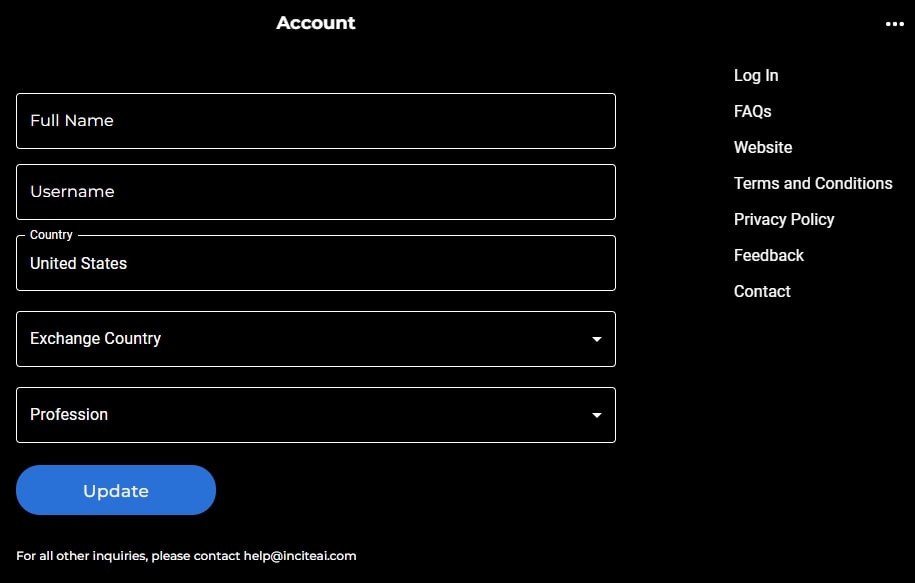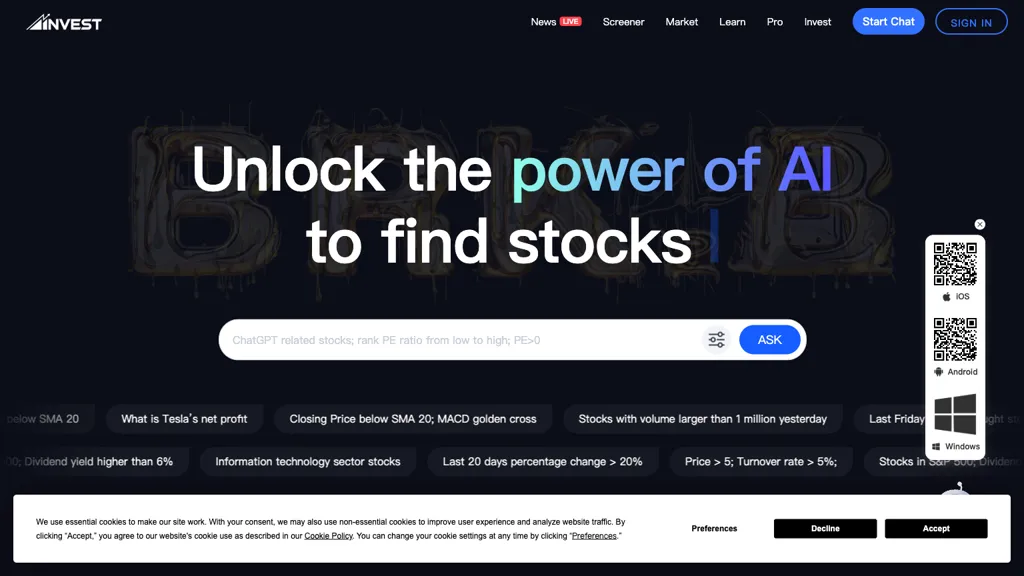To ensure that you are providing accurate and reliable data, it's important to check the data and sources that are utilized by AI trading and stock prediction platforms. Insufficient data could lead to poor forecasts, financial losses and mistrust of the platform. Here are ten of the most effective ways to assess data sources and the quality.
1. Verify the data sources
Check the origin of the data Check that the platform uses reputable and well-known data providers (e.g., Bloomberg, Reuters, Morningstar, or exchanges like NYSE, NASDAQ).
Transparency. Platforms should make their data sources clear and be updated regularly.
Don't rely solely on one source. Trustworthy platforms frequently combine data from different sources to lessen the chance of bias.
2. Examine the freshness of data
Real-time vs. delayed data: Find out if the platform provides actual-time data, or delayed data. Real-time data is crucial to ensure that trading is active. Data that is delayed can be sufficient for analysis over the long-term.
Update frequency: Make sure to check the frequency at when data is changed.
Accuracy of historical data Make sure that data is uniform and free of any anomalies or gaps.
3. Evaluate Data Completeness
Look for missing data.
Coverage: Ensure whether the platform you are using supports many the indices and stocks that are relevant to your plan.
Corporate actions: Make sure the platform is able to be able to account for splits in stock or dividends. Also, verify if it can account for mergers.
4. The accuracy of test data
Cross-verify data: Examine the data of the platform with other trusted sources to ensure the accuracy of the data.
Find errors: Check for asymmetry, inaccurate prices, and mismatched financial metrics.
Backtesting. You can backtest strategies by using data from the past and compare the results to what you expected.
5. Assess the Data Granularity
The level of detail: Make sure that the platform can provide detailed data, such price quantity, bidding-asking spreads and order book depth.
Financial metrics: See if the platform provides comprehensive financial statements (income statement and balance sheet, as well as cash flow) and key ratios (P/E P/B, ROE, etc. ).
6. Make sure that the data processing is checked and Cleaning
Normalization of data: To keep consistency, ensure the platform normalizes every data (e.g. by adjusting for dividends and splits).
Outlier handling - Check out the way your platform handles anomalies, or data that is not outliers.
Imputation of missing data is not working - Make sure that the platform is using effective methods to fill in the data gaps.
7. Check data consistency
Timezone alignment - Make sure that all data is aligned with the same local time zone to avoid discrepancies.
Format consistency: Ensure that the information has been presented in a consistent manner (e.g. units, currency).
Cross-market consistency : Verify data Harmonization across various exchanges or markets.
8. Relevance of Data
Relevance to trading strategy: Ensure the data aligns with your trading style (e.g., technical analysis, quantitative modeling, fundamental analysis).
Check the features of the platform.
Verify the security and integrity of your data
Data encryption: Check whether the platform uses encryption to safeguard data while it is transferred and stored.
Tamperproofing: Check that the data hasn't been altered, or manipulated.
Check for compliance: Make sure that the platform you are using is compliant with any laws governing data protection (e.g. GDPR, the CCPA).
10. Transparency of the AI model's transparency on the Platform is testable
Explainability. You must comprehend how the AI uses data to make predictions.
Check if there is a bias detection feature.
Performance metrics - Examine the track record of the platform as well as its performance indicators (e.g. : accuracy, recall and precision) in order to evaluate the accuracy of the predictions made by them.
Bonus Tips
Reputation and reviews of users Review the user feedback and reviews in order to evaluate the platform reliability and data quality.
Trial period. You can avail an unpaid demo or trial to test out the features of the platform.
Customer Support: Verify that the platform has a robust support system for customers to resolve data-related issues.
With these suggestions to help you better evaluate the quality of data and sources of AI platform for stock predictions to ensure you take informed and reliable trading decisions. Read the recommended inciteai.com AI stock app for site advice including ai stock trading app, ai stocks, ai for trading, ai stock, best ai trading software, ai stock market, ai chart analysis, ai chart analysis, ai chart analysis, ai investing platform and more.

Top 10 Suggestions To Judge The Speed And Latency Of Ai Stock Trading Platforms
The speed and the latency of a trading platform are crucial factors to take into consideration, particularly when it comes to active traders or high-frequency investors, as well as algorithmic ones. Even milliseconds in delay can negatively impact profitability and trade execution. Here are ten top tips to assess the speed and latencies of these platforms.
1. Real-time data feeds: How can you evaluate them
Time to deliver data: The platform must provide real-time, accurate information within a short period of time (e.g. with sub-millisecond delays).
Nearness of the data source: To decrease the amount of time required to transfer data, make sure whether your server's servers are able to be situated near major exchanges.
Data compression: Determine if the platform is using efficient data compression in order to speed up data delivery.
2. Test Trade Speed of Execution
Speed of processing orders: How quickly the platform completes and processes trades once you've submitted an order.
Direct Market Access (DMA) Make sure that your platform supports DMA. This allows orders to go directly to the exchange without the necessity of intermediaries.
Execution Reports: Verify if your platform provides specific reports on the execution of orders, as well as timestamps.
3. Assess Platform Responsiveness
User interface (UI) speed: Test how quickly the platform's UI responds to inputs (e.g. pressing buttons or loading charts).
Chart updates. Verify that charts and visualizations have a real-time update without lag.
Performance of mobile applications: When using a mobile app make sure it is as fast as the desktop version.
4. Check for Low-Latency infrastructure
Server Locations: Select servers that have low latency and are near major financial centers, or exchanges.
Co-location service: See if the platform offers co-location, which allows the hosting of your trading algorithms on servers that are close to the exchange.
High-speed networks: Check if the platform uses fiber optic networks with high-speed speeds or low-latency technology.
5. Backtesting the simulation speed and test backtesting
Find out how quickly the platform analyzes and processes historical data.
Simulation latency: Make sure the platform is able to simulate trades in real time without any noticeable delay.
Parallel processing: Check that the system is running parallel processing, or distributed computing to speed up complex computations.
6. Measure API Latency
API response: The API's API is evaluated by the amount of time it takes to respond to requests.
Rate limits: Check whether API has reasonable rates limits in order to avoid delay during high-frequency trades.
WebSockets Support: Confirm that the platform utilizes WebSockets protocols for low-latency real-time streaming of data.
7. Test Platform Stability with Load
Simulate scenarios of high-volume trading to determine if the platform is stable and responsive.
Try the platform out in periods of high volatility in the market to ensure it is able to handle sudden changes in price.
See if there are tools that can be used to test strategies in extreme situations.
8. Examine network and connectivity
Internet speed requirement: To achieve maximum performance, ensure that your internet connection speed is at the recommended speed for your platform.
Redundant Connections: To prevent delay, verify that the platform can support redundant internet connections.
VPN latency - If you use a VPN to connect, be sure that it doesn't cause significant latency. Also, make sure the service offers alternatives.
9. Look for Speed Optimisation Features
Pre-trade analytics: Make sure that the platform has pre-trade analysis to optimize the speed of execution and order routing.
Smart Order Routing (SOR). Check if the platform is using SOR to identify the quickest and most cost efficient execution venues.
Monitoring latency: Check that the platform offers tools to analyze and monitor latency in real time.
Review user feedback and benchmarks
Reviews from users: Perform user research to evaluate the platform's speed and latency.
Benchmarks by third-parties: Check for independent benchmarks and reviews which evaluate the platform's performance to those of its competitors.
Case studies: Check whether the platform has case studies, or testimonials, that highlight its abilities to provide low-latency.
Bonus Tips:
Trial period: Take a the free trial or demo version of the platform to check out the performance of the platform in real-world scenarios.
Support for customers: Make sure the platform offers customer support to optimize the latency of your system or address other issues.
Hardware requirements: Check if the platform requires specific hardware (e.g. high-performance computers) to run at maximum speed.
The following tips can assist you in evaluating the speed of AI trading platforms that predict/analyze the prices of stocks. It will allow you to choose a trading platform which best suits your needs in trading and reduces any delays. Low latency is especially crucial for high-frequency and algorithmic traders, where even small delays can have a significant impact on profitability. See the most popular ai options advice for blog recommendations including ai stock prediction, investing with ai, ai options trading, ai stock analysis, how to use ai for stock trading, ai in stock market, best ai penny stocks, can ai predict stock market, best ai trading platform, stock predictor and more.
